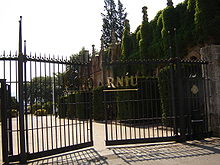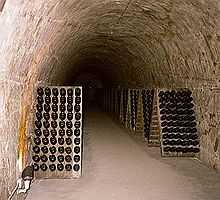Cava
Cava , el cava (vi escumós) , German : champagne (after bottle fermentation method ) , is a sparkling wine and one of the most famous specialties of Catalonia .
history
Josep Raventós i Fatjó began producing sparkling wine using the bottle fermentation method at the Can Codorníu winery in the Penedès region in 1872 , thus laying the foundation for the production of cava.
José Raventós is often mentioned as the inventor of the Spanish sparkling wine, who allegedly first produced a sparkling wine in Sant Sadurní d'Anoia in today's DO Penedès in 1872. Here, however, the records contradict each other, because Antoni Gali Comas was already producing a sparkling wine in 1850. Luis Justo y Villanueva (1834-1880), laboratory director of the Agricultural Institute Institut Agrícola Català de Sant Isidre , who studied and taught the bottle fermentation method , is also mentioned. In 1872 three of his students presented sparkling wines at a competition in Barcelona. The fact is, however, that Josep Raventós, as head of the Codorníu company, was the first to produce sparkling wine from today's standard varieties Parellada , Xarel·lo and Macabeo and was the first to bring it to market (1879).
Back then, sparkling wine was named after French champagne (Catalan Xampàn and Spanish Champaña or Champán ). In 1986 Spain joined the EU . At the same time, but independently of this, a new name had to be used for legal reasons, because the term “champagne” was no longer allowed to be used.
In Spain a distinction is made between cava and bodega - both mean " winery ". A bodega , however, is usually a simple, earth-covered but mostly ground-level building, while a cava is always built underground, as the sparkling wine matures best under cool temperatures during yeast storage and this was originally the easiest to do underground. The winemakers then called their products produced above ground "Bodega wines" and the sparkling wines produced underground "Cava".
Since 1986, Cava has been protected with the quality designation Denominació d'Origen Cava (in Catalan ) or Denominación de Origen Cava (in Spanish ) - in this case DO Cava does not mean a designation of origin from a specific region, but a quality label. A star is burned into the cork of a real cava. The other sparkling wines (which cannot be called cava ) are called Fermentació en ampolla or Fermentación en botella .
Approved types of wine
For white cavas, the varieties Parellada , Xarel·lo , Macabeo (Viura), Subirat (Malvasia Riojana), Chardonnay and, since May 2007, also Pinot Noir , and for Rosados Monastrell and Garnacha Tinta are approved.
Manufacture / places
A total of 159 municipalities in Spain are approved for the production of cava. The requirements for it are comparable to those for crémant or champagne from France . It is made using the bottle fermentation process from the white grape varieties Xarel lo , Macabeo, Parellada, i.e. as Blanc de Blancs , but also from Chardonnay grapes as well as Garnatxa , Monastrell , Trepat and Pinot Noir . The strong and sugar-rich Xarel·lo gives the wine body and alcohol, Parellada provides the elegance and Macabeu provides the fruitiness with the typical aromas of apple. The minimum storage period on the yeast is nine months for all cavas and two years for cavas with a vintage. The Gran Reservas are left on the lees for at least 30 months. The regulations also include that the alcohol content is between 10.8 and 12.8 % by volume , referred to as degrees (°) in Spain.
Around 96% of cava production takes place in the wine-growing region of Penedès west of Barcelona . The large wineries Freixenet , Codorníu , Juvé y Camps , Marqués de Monistrol , Segura Viudas and Josep Masachs are located near the town of Sant Sadurní d'Anoia , about 50 km west of Barcelona and can in part also be visited. The place, built on a chalk cliff, has numerous aging cellars. More than 200 cava manufacturers have their home there. In the large cellars, small trains transport the grapes and bottles on rails underground.
Manufacturer
With more than 200 million bottles a year, Spain is the second most important source of quality sparkling wine in the world after France. In 2010, production increased again by eleven percent to 245 million bottles. 95 million of these were sold on the home market and 150 million were exported, 41 million of which to Germany alone. Well-known producers are Cava Guilera, Albet i Noya, Castellblanch, Castell d'Age, Castillo Perelada, Codorníu, Freixenet, Jané Ventura, Jaume Serra, Juve y Camps, Marqués de Monistrol, Masía Bach, Miguel Torres, Oliveda, Parxet, Pere Ventura , Pinord, Raïmat, Rondel, Segura Viudas, Torelló, Vallformosa.
sorts
The usual cava has the flavor brut , dry with less than 15 g / l residual sugar. The Extra Brut flavor with less than 6 g / l residual sugar and the Brut Nature flavor <3 g / l residual sugar are also offered. Extra Dry (or extra-Sec ) has from 12 to 20 g / L residual sugar, Dry (cat. Sec , span. Seco ) 17 to 25 g / l, Semi Dry (cat. Semi Sec , span. Semiseco ) 33 to 55 g / l and sweet (cat. Dolç , span. dulce ) at least 50 g / l residual sugar.
With Reserva and Gran Reserva as quality designations (depending on the maturation time in the bottle of 18 or 30 months), there are products that come close to French quality brands in terms of price. Connoisseurs appreciate the voluminous, aromatic flower of the top cavas - even the Brut natural , with no residual sugar content, are by no means sour, but light and tangy.
Quality regulations
- Cultivation: planting density per hectare between 1500 and 3500 vines
- Yield: white grapes: 12,000 kg / ha; Red grapes: 8,000 kg / ha
- Pressing: from 150 kilograms of grapes a maximum of 100 liters of wine
- Base wine: alcohol content between 9.5 and 11.5% by volume
- Sparkling wine: fermentation on the lees for nine months, at the earliest one year after harvest on the market
- Quality cavas lie on the yeast longer: after 15 months they are considered Reservas and after 30 months as Gran Reservas .
- Alcohol content between 10.8 and 12.8% by volume
- Acidity min. 5.5 g / l
- Pressure min. 3.5 bar at 20 ° C
Others
The DO Cava is not limited to the Penedès wine region. Cava is also produced on a small but growing scale in other Spanish growing areas such as Rioja , Aragón , Navarra and in other specially registered municipalities.
literature
- Roland Bill: Cava - more than an analytical consideration. (pdf) ( Memento from October 17, 2017 in the Internet Archive ) In: Swiss Journal for Fruit and Wine Growing Issue 11/2001. Federal Research Institute Wädenswil, today Agroscope, 2001
Individual evidence
- ^ Diccionario Salamanca de la lengua española . Universidad de Salamanca, 1996, ISBN 84-294-4371-1 , pp. 305 .
- ^ Source: Schweizerische Weinzeitung, edition: August 2008.
- ↑ Report in AVUI from February 28, 2011 .


